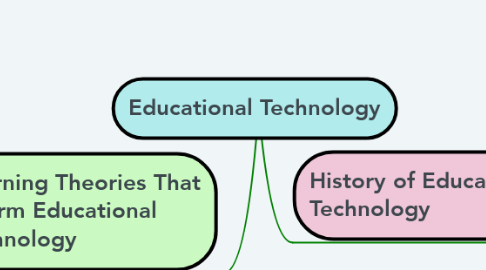
1. Learning Theories That Inform Educational Technology
1.1. Behaviourism
1.2. Constructivism
1.2.1. Piaget's Cognitive/Personal Constructivism: 4 stages of cognitive development must be followed by an individual
1.2.2. Bruner’s Theory of Constructivism: Knowledge is developed when an individual completes 3 cognitive stages (Enactive, Iconic, Symbolic)
1.2.3. Vygotsky’s Theory of Social-Constructivism: Learning requires interaction between the individual and others (peers, teacher), as culture and society shape learning context
1.3. Constructionism
1.3.1. Seymour Papert's Theory of Constructionism: An individual constructs knowledge better when they create a tangible artefact that others will see and use
1.4. Cognitivism
1.4.1. Learning involves the association of new information in pathways that an individual has previously used to process and store information
1.5. Cognitive Load Theory
1.5.1. Learning requires the storage of information from the working short-term memory into long-term memory
1.6. Connectivism
1.6.1. Learners in a connected network benefit from and contribute to a learning community
1.7. Situated Learning and Communities of Practice
1.7.1. Learning requires a learner to collaboration in an authentic learning environment where knowledge is shared
2. History of Educational Technology
2.1. 1920: Sidney Pressey created an automated teaching machine
2.2. 1930: M.E Lazerte created the problem cylinder, which presented a problem and checked students' answers
2.2.1. 1960: Don Bitzer created PLATO - the first programmed computer-assisted instruction system
2.2.2. 1966: IBM 1500 Series machines created, based on computer-assisted instruction
2.2.3. Digital Equipment Corporation created Vax 11-785 - a computer used for computer-assisted instruction
